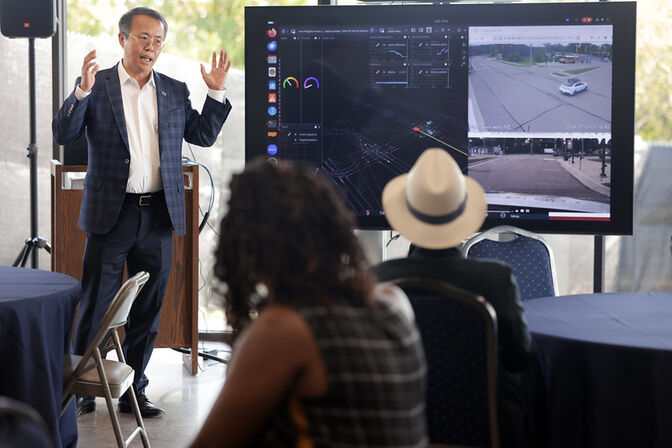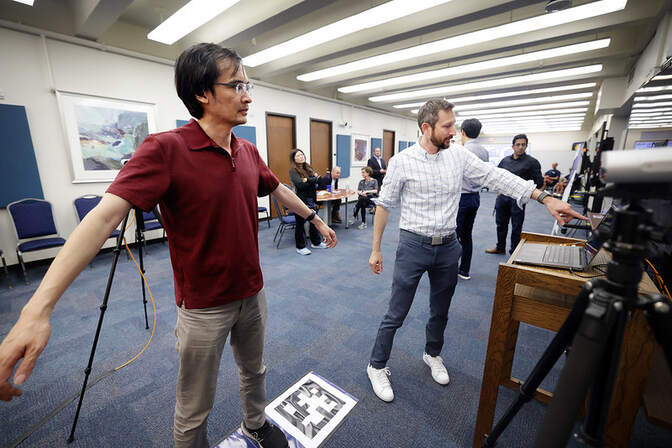
U.S. presidential advisory council visited U-M for transportation & mobility research
‘There’s an intellectual milieu and an enthusiasm that’s palpable.’

‘There’s an intellectual milieu and an enthusiasm that’s palpable.’
Experts
Sensors to streamline handoffs between self-driving cars and humans. Powered prosthetic legs that smoothly navigate stairs. Vehicles that detect a driver’s mental load and adjust to it. These and many more groundbreaking transportation and robotic technology research efforts were in the limelight when the President’s Council of Advisors on Science and Technology (PCAST) visited the University of Michigan recently.
PCAST is a group of leading scientists and engineers appointed by U.S. presidents to give guidance on science, technology, and innovation matters.
The research-centric visit was connected to the council’s charge to explore what’s on the horizon for mobility and transportation. It took place in September, a day after members convened in Detroit to hear from experts and discuss the future of transportation, transportation planning and implementation.
“Given that we wanted to focus on transportation innovation and research, Michigan was the obvious place to go,” said PCAST co-chair Maria Zuber, the E. A. Griswold Professor of Geophysics and presidential advisor for science and technology policy at MIT.
Council members were impressed not only by the labs they saw, but also the people they met.
“When you go into a lab, the students want to talk about their work. There’s an intellectual milieu and an enthusiasm that’s palpable. That drives a faster pace of innovation,” said Steve Pacala, the Frederick D. Petrie Professor Emeritus in the Department of Ecology and Evolutionary Biology at Princeton University.
The advisors toured:
With demos of more than 15 projects and prototypes, engineering faculty and students provided broad and deep perspectives of the ways U-M is driving the future of mobility.
“For more than a century, our work has made transportation safer, cleaner and more affordable, as well as contributed to national security,” said Karen A. Thole, the Robert J. Vlasic Dean of Engineering and a professor of mechanical engineering and aerospace engineering. “As we hope you discover over the course of your visit, we are bringing together expertise in mobility and transportation across the University to address the complex challenges our state and nation face right now, and those of the future.”
Mcity was built to represent the real world, Managing Director Greg McGuire told the advisors.
“It’s different than a proving ground you may have seen in industry where they’re testing brakes and traction control. We’re testing the brains of the connected and automated vehicles, and how these systems interact with us and with infrastructure to improve safety. And we’ve got the best 5G network in the U.S. here to do it.
“Forty thousand Americans die every year in our ground transportation network. The opportunity isn’t just huge, it’s imperative.”
Henry Liu, Mcity director and professor of civil and environmental engineering, discussed the Mcity Safety Assessment Program, a methodology for testing autonomous and connected vehicles that offers a path to nationwide standards.

“AVs are on the cusp of scale deployment. I can assure you the technology will be mature enough soon, but I don’t think society is ready.” Liu said. “We need to answer questions like: How safe is safe enough? How do we license AVs? A standard testing protocol is a critical piece.”
Council members participated in a demo of teleoperation. In the demo, a volunteer sitting in a simulator in the Mcity workshop controlled a real vehicle on the test track, navigating the physical roadway and virtual traffic. It’s one of Mcity’s remote capabilities.
“It’s great to see the technology become manifest,” said PCAST member Terence Tao, a mathematics professor at the University of California, Los Angeles. “As a mathematician, I’ve been thinking about AVs for a while—the theory of how to best network vehicles together. Around five years ago, people thought AVs were around the corner, but it fizzled out because of edge cases. I feel like we’re over the hype and it’s finally really real and that’s exciting.”
Among the demonstrations at UMTRI were a 30-mph crash test, driver-monitoring sensors to improve human/AV handoffs and body scanning technology that has helped the military, industry and academic researchers better understand how to protect people with a broader range of body shapes.
“As soon as you landed in Southeast Michigan you were in our lab,” said UMTRI external engagement manager Eric Wingfield, speaking of the Ann Arbor Connected Vehicle Environment, which is outfitting nearly 75 intersections and other sites with cellular vehicle-to-everything (C-V2X) technology to improve safety for all road users.
“One of the things that’s a strength of U-M is that we can do testing at Mcity and then move it out to traffic,” Wingfield added.

UMTRI also has one of the few university-based crash test sled labs. Today researchers there are focusing on safety for children and wheelchair users. They ran a live test of a collision at 30 mph—considered moderately severe. It was over in 80 milliseconds. Council members then watched the high-speed footage in slow motion, noting the whiplash in the crash test dummy’s neck that wasn’t visible in real time.
Other UMTRI researchers are focusing on driver behavior in partially automated vehicles. Today’s advanced driver assistance systems rely on operator monitoring sensors to determine whether the driver is paying enough attention to take over if necessary, explained Monica Jones, UMTRI associate research scientist.
PCAST member Inez Fung, professor of atmospheric science at the University of California, Berkeley, shared that she switched her car out of its “self-driving” mode after realizing how disengaged in the road she had become.
“How can it tell if my mind is somewhere else?” Fung asked.
“There is no ground truth,” Jones answered. “We need to understand how to detect mind-wandering.”
Industry is working on this “driver state monitoring” problem, and so are Jones and others at U-M.
Two- and four-legged robots that adapt their gaits to their environments, advanced prosthetics and lightweight exoskeletons were on display at the Ford Motor Company Robotics Building.

Researchers demonstrated a powered prosthetic leg whose sophisticated control strategy and sensor suite allows it to smoothly transition between flat ground and stairs. And robotics doctoral student Andrew Seelhoff, an above-the-knee amputee, described how the team is working to optimize the system for practical use.
They’re also enabling other labs’ innovations through an open-source project.
“The average lab would have to build their own leg to test their algorithms,” said Kevin Best, a doctoral student in robotics. “But people who are good at control theory aren’t also good at prosthetic design. We’re trying to get whatever good ideas people have out into the world to expedite solutions.”
PCAST member Paula Hammond, a chemical engineering professor at MIT, was moved by what she saw, including the lightweight exoskeleton that can help stabilize a wearer’s gait.
“I’m fascinated by the extent to which engineering meets real-world applications here,” she said.
“My mom had Parkinson’s. It’s wonderful to watch young people design robots that can help change a person’s life.
“And you’ve included the behavioral sciences,” she continued. “This kind of integration is critical to helping students become interdisciplinary agents in the world and create the next big things.”
At the Automotive Research Center, advisors saw simulation technology that could help humans more effectively interact with machines in situations like disaster relief, agriculture, forestry, defense and space exploration.
One of ARC’s focuses is human-autonomy teaming. Researchers gave a glimpse into a system of wearable sensors that measures a human operator’s breathing rate, face temperature, heart rate and even brain activity using a technique called functional near-infrared spectroscopy. The goal is to provide the vehicle with information it can use to adapt.

“We go beyond thinking of the vehicle as a device to thinking of it as a teammate—one that understands the cognitive and emotional state of the human, whether they’re tired or overwhelmed,” said Bogdan Epureanu, ARC director and Roger L. McCarthy Professor of Mechanical Engineering.
For PCAST member Dennis Assanis, president of the University of Delaware, the lab was familiar. Assanis served as director of ARC for a time during his 17 years at Michigan Engineering.
“Michigan is an amazing institution,” Assanis said. “I’m impressed with how the university continues to invent the future. ARC has been here for 30 years. To me, the success is that the work gets passed on and grows.”
At the U-M Battery Lab, PCAST members were ushered through an IP-protected safe zone where industry and academic researchers from around the globe prototype, test, scale-up, and analyze batteries and the materials that go into them.
“Our existing pilot line offers near industrial-scale material processing capabilities, and our users have relied on it for everything from new material research to product validation,” said Greg Less, Battery Lab managing director.
Plans are underway for multiple rounds of expansion through the $130 million, state-funded U-M Electric Vehicle Center.
“I am impressed that the University of Michigan, as a public university, has such great research programs that really pull resources together,” said PCAST member Laura Greene, chief scientist at the National High Magnetic Field Laboratory and the MarieKrafft Professor of Physics at Florida State University. “I really believe in the future of public universities for educating our students in a diversity of research and education areas.”
Nicole Casal Moore
Communications & Public Engagement Director